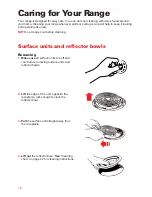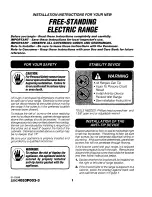
4
I M P O R T A N T S A F E T Y I N S T R U C T I O N S
cooktop, and the oven door,
could also become hot enough to
cause burns.
•
Do not store flammable materials
on or near the range. The fumes
could create an explosion and/or
fire hazard.
When using the cooktop
•
Make sure the reflector bowls are
in place during cooking. Cooking
without reflector bowls could sub-
ject the wiring and components
underneath them to damage.
•
Do not line reflector bowls with
aluminum foil or other liners. Im-
proper installation of these liners
could result in a risk of electric
shock or fire.
•
Select a pan with a flat bottom that
is about the same size as the
surface unit. If pan is smaller than
the surface unit, some of the heat-
ing element will be exposed and
could result in the igniting of cloth-
ing or pot holders. Correct pan size
also improves cooking efficiency.
•
Check to be sure glass cookware
is safe for use on the range. Only
certain types of glass, glass-ce-
ramic, ceramic, earthenware, or
other glazed cookware are suitable
for cooktops without breaking due
to the sudden change in tempera-
ture.
•
Do not wear loose or hanging
garments when using the range.
They could ignite if they touch a
hot surface unit and you could
be burned.
•
Use only dry pot holders. Moist or
damp pot holders on hot surfaces
could result in burns from steam.
Do not let pot holder touch hot
heating elements. Do not use a
towel or bulky cloth for a pot
holder. It could catch on fire.
•
Keep range vents unobstructed.
•
Do not heat unopened contain-
ers. They could explode. The
hot contents could cause burns
and container particles could
cause injury.
•
Use only cookware approved for
oven use. Follow cookware
manufacturer’s instructions,
especially when using glass or
plastic cookware.





































